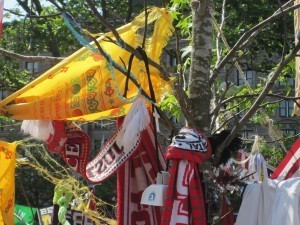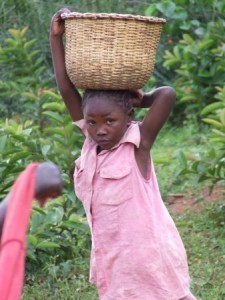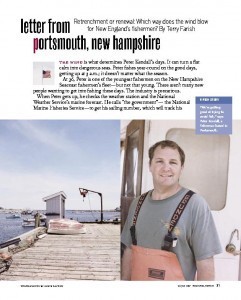Terry Farish's Blog, page 26
June 1, 2013
Scenes from a Kenyan Home
May 31, 2013
A Boston Story
I went to the Boston Public Library yesterday where I was meeting my editor, Melanie Kroupa, to accept the Boston Authors Club  Young Reader Award. I took the train into North Station. As I traveled south from New Hampshire, fierce pain from a headache was building. By the time I travelled from North Station on the green line to my stop at Boylston Street, all I could think of was finding relief. Coming up the stairs from the T, my eyes keyed in on a sign – CVS. I got my pills, slowly walked across the street where I saw benches beside what looked like a flea market. Across Dartmouth Street was the block-wide, grand BPL. I sat, took the pills, drank cold water. Sitting absolutely still, I let the pain slowly shift and ease. I was aware I was not cold, after days of cold rain. I began to take in the space where I’d found this bench. A busy park, people crossing in every direction. Looking like summer. I turned and saw behind me dozens of pairs of tennis shoes tied on a metal stand. They weren’t new shoes. I looked beyond them. More shoes, bears, banners, caps, bouquets. This was the Marathan Memorial. This was Copley Square.
Young Reader Award. I took the train into North Station. As I traveled south from New Hampshire, fierce pain from a headache was building. By the time I travelled from North Station on the green line to my stop at Boylston Street, all I could think of was finding relief. Coming up the stairs from the T, my eyes keyed in on a sign – CVS. I got my pills, slowly walked across the street where I saw benches beside what looked like a flea market. Across Dartmouth Street was the block-wide, grand BPL. I sat, took the pills, drank cold water. Sitting absolutely still, I let the pain slowly shift and ease. I was aware I was not cold, after days of cold rain. I began to take in the space where I’d found this bench. A busy park, people crossing in every direction. Looking like summer. I turned and saw behind me dozens of pairs of tennis shoes tied on a metal stand. They weren’t new shoes. I looked beyond them. More shoes, bears, banners, caps, bouquets. This was the Marathan Memorial. This was Copley Square.
I had read about the controversy here. Boston was asking, What are we going to do with this makeshift memorial? I stood and walked through it the, across the park. It was terribly intimate in objects and mementoes. It was multicultural as Boston is, with messages in many languages on banners and a large black board. Boston may not know what to do with it, but to me, suddenly finding myself among these personal artifacts of pain and loss and wishes for a city’s strength made it the most intimate memorial I have experienced.
I made my way across Dartmouth Street and up the stairs of the Boston Public Library, past the bronze statues representing Art & Science and to the good people of the Boston Authors Club and Melanie and the fine writers who had gathered there. I met writers and poets and editors and passionate readers. I met Lois Lowry who was honored for Life Time Achievement. I was among people charged with telling the stories of human pain and loss and hope. Cynthia Levinson who wrote We’ve Got a Job, Martha Collins who wrote White Papers, Junot Diaz who wrote This is How You Lose Her and many more wonderful writers. Thank you Boston Authors Club, Karen Day, Erin Dionne, Sarah Lamstein, Susan Meyer, Kim Triedman, Judith Cohen, Alan Lawson, Helen Marie Casey, Vera Lee for bringing us together and honoring us this day.
May 20, 2013
The Story Behind the Lupine Award
The Good Braider has won the Lupine Award from the Maine Library Association. Here’s some backstory on this award. The award is named for the flowers grown in Barbara Cooney’s picture book, MISS RUMPHIUS. I just listened to the story on this beautiful audio book version:
Miss Rumphius, who had once been a young girl named Alice, told her grandfather, “I will go to faraway place and come home to live by the sea.” Her grandfather said that was a good idea but he said there was one thing she must do. “You must do something to make the world more beautiful.” And she did. She grew at her place by the sea purple and lavender lupines. I’m glad that Maine librarians found the beauty of Viola’s very difficult story. I think it is in her strength.
One more part of the story – All the librarians in Maine who honored writers and illustrators with the Lupine Award wore shades of lavender and purple. And I did, too. Here are all the winners: Matt Tavares, me, Betsy Thompson, and Mary Cerullo.
April 13, 2013
Madhu’s Seeds

Illustration by Ram Darjee
An essay for spring published in New Hampshire Home‘s back page feature ”At Home in New Hampshire.”
by Terry Farish
Madhu Bhandari tells me, “When I bring the greens home from the garden, that is the best thing.”
I am in her home in downtown Concord where she lives with her husband; her children, including her grown son Nilhari and daughter-in-law Devika; and grandchild, Neeja.Devika sits with us and translates for Madhu, who speaks Nepali. Dressed in turquoise trousers and a white shirt, Madhu is “wearing pote,” glass pote beads around her neck that say she is married.
“What kind of greens?” I ask.
“Mustard,” she says. She plants mustard seeds and harvests the leaves three times in a New Hampshire growing season in Sycamore Community Garden.Not in rows, she explains. That makes the seeds dry out. With the mustard greens, she makes gundruk— fermented mustard leaves that she keeps in a baggie all year long for gundruk soup.
In Bhutan, Madhu used to grow sugar cane with her family. She remembers the processing steps and taking the sugar to sell in the market at Dagapela. She grew mustard and spices for cooking: ginger, coriander, garlic, onions, dill.
When the government of Bhutan adopted the “One Nation, One People” policy, the Bhandaris lost their home and their growing fields. They were expelled from Bhutan and settled in a refugee camp in Nepal.
For eighteen years—before Neeja was born, before Devika and Nilhari married—Madhu lived in the refugee camp with her husband and children. Every two weeks, they received food supplies from the United Nations. The refugees didn’t grow any of their foods in the camps. They were farmers with no land.
They waited in the camps for a political resolution to allow them to return to their farm. None came. In 2008, the Bhandari family was resettled by Lutheran Social Services to Concord.
In 2009, Sycamore Community Garden opened. Madhu was offered one of the first fifty-four plots on the edge of the New Hampshire Technical Institute campus beside Fort Eddy Pond. After eighteen years in Nepal and a year in a Concord apartment, Madhu began to cultivate a patch of land.
With Neeja in her arms, Madhu goes to the kitchen. She returns with a yellow cloth that she unties to show a mound of mustard seeds. She also brings a plastic bag of small dried strips, gundruk.
She invites me to taste, and I do. It is pungent and sharp.Devika—who wears long black boots and a sweater dress, and does not wear pote—explains gundruk. Madhu chops the leaves into strips and ferments them with garlic, turmeric and fennel for about seven weeks. She gives me a small bag of gundruk, and Devika writes a recipe for gundruk soup so I—an Irish-American—can add it to my repertoire of various potato and tomato soups.
Madhu lost her family farm in Bhutan but she says, in a master ful summing up of her resilient nature, “I can make gundruk here.” Neeja, wearing her pink, sparkling tennis shoes, will grow up American, not on a farm in Bhutan. But because of the garden, she will also grow up knowing how to ferment mustard greens to make gundruk soup. She will grow up with a Bhutanese grandmother who, in the winter, keeps a man’s palm-full of mustard seeds tied in a yellow, cotton cloth, ready to scatter in the spring garden in New Hampshire. She will grow up sustained by her ancestors.
Devika Bhandari’s Gundruk Soup
Boil two potatoes. Mash.
Cut ½ onion into small pieces.
Chop 2 tomatoes into small pieces.
Put oil in a cooking pan and fry the onion until it gets brown.
Add the washed gundruk and chopped tomatoes with a little water.
When the tomatoes are tender, add the mashed potato and a little water.
Let it boil. For seasoning, add ginger, garlic and coriander leaves at the very end.
April 12, 2013
“The Writer’s Life” in Cambridge, MA
 I’ll be speaking at a National Writers Union/Cambridge Center of Adult Education event on May 1st on a difficult subject. Writing About the Unspeakable is the name of the program in The Writer’s Life series. On the panel with me are Mark Vonnegut author of THE EDEN EXPRESS and Iris Gomez author of TRY TO REMEMBER.
I’ll be speaking at a National Writers Union/Cambridge Center of Adult Education event on May 1st on a difficult subject. Writing About the Unspeakable is the name of the program in The Writer’s Life series. On the panel with me are Mark Vonnegut author of THE EDEN EXPRESS and Iris Gomez author of TRY TO REMEMBER.
April 7, 2013
Georgia Peach Book Award Nomination
the good braider is making its way to readers with the help of some wonderful awards. Just found out the novel is nominated for the Georgia Peach Book Award in the state of Georgia. Georgia teens will read the 20 nominated books over the year and select the winner in 2014. Here are some other recognitions the good braider has received ~
SLJ Best Book of the Year
American Library Association YALSA Best Fiction for Young Adults
Starred Booklist review
Starred SLJ review
& it’s a Goodreads Best Multicultural Young Adult Book selection
Thank you, all my readers!!
March 22, 2013
For you, an elephant …and maybe good luck
 If you’d like a signed book plate for The Good Braider, e-mail me and I’ll send you one. tfarish at gmail. Be sure and tell me who you’d like the book inscribed to. This book plate was designed by Ex Libris and I found it on Etsy.
If you’d like a signed book plate for The Good Braider, e-mail me and I’ll send you one. tfarish at gmail. Be sure and tell me who you’d like the book inscribed to. This book plate was designed by Ex Libris and I found it on Etsy.
March 11, 2013
Celebrating with Enterteenment





The young immigrants in The Good Braider were honored as part of the spring ENTERTEENMENT celebration at the Prudential Center in Boston. Jessica of the Young Broadcasters of America interviewed me about writing the novel in an event recorded and and produced by Lauren of YBA. Enterteement is a youth empowerment organization and online and print magazine. Amanda Mills Wills, CEO, surely is empowering youth with the featured speakers at the event, 16-year old Rachel D’Ambrosio who told her personal experience with melanoma and presented with the Melanoma Foundation and 19-year old Ava Anderson who presented about her own cosmetics company, Ava Anderson Non-Toxic. 17-year old Viola of my book was in wonderful company with these strong young women.
March 7, 2013
Links for Writers
One of my favorite children’s book writers is Ann Cameron, author of Stories Julian Tells and many more stories. It is such a simply told story with great heart. I came upon her site and then to her page I’m passing on to you as the first link in this list of Links for Writers.
For Writers by Ann Cameron







